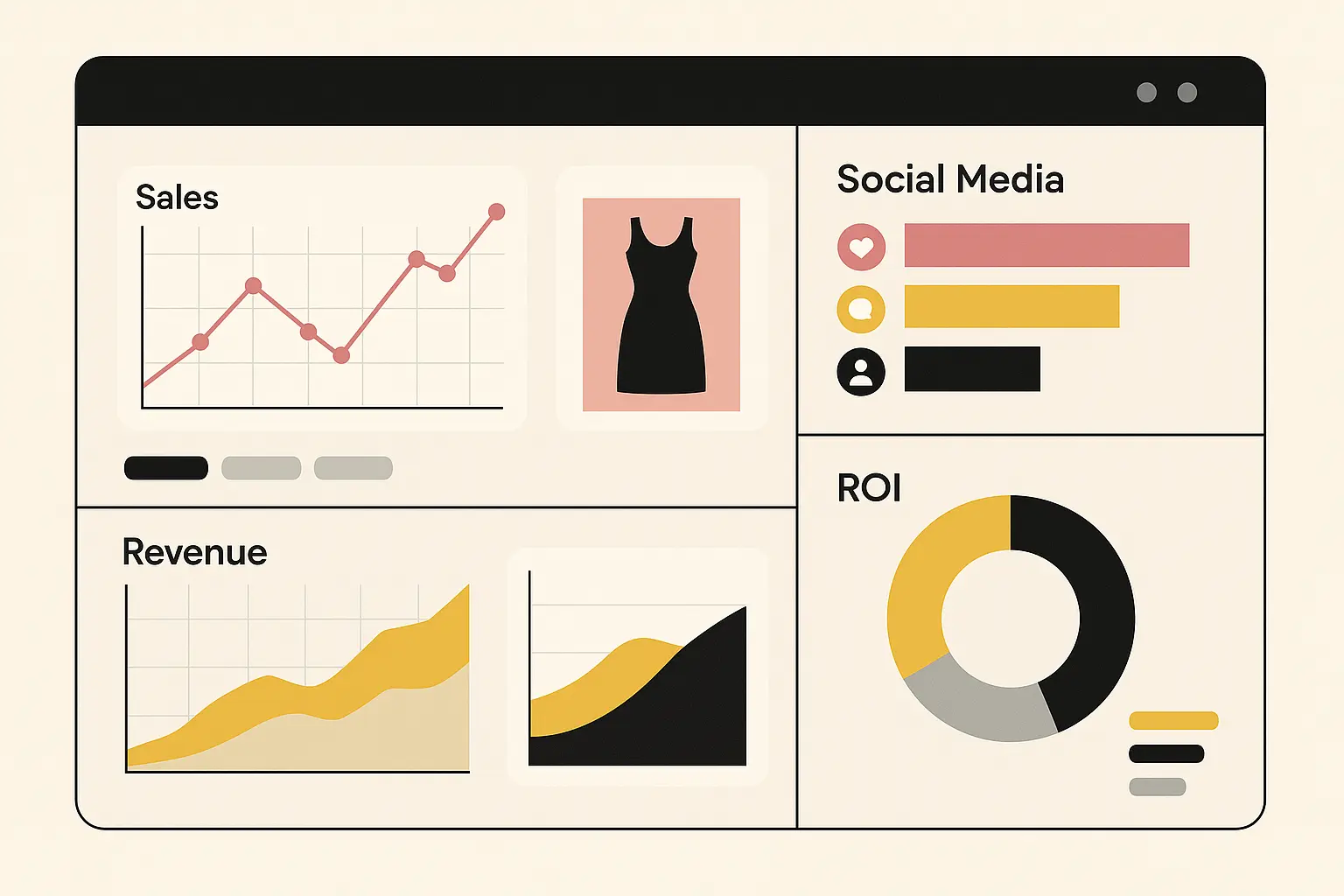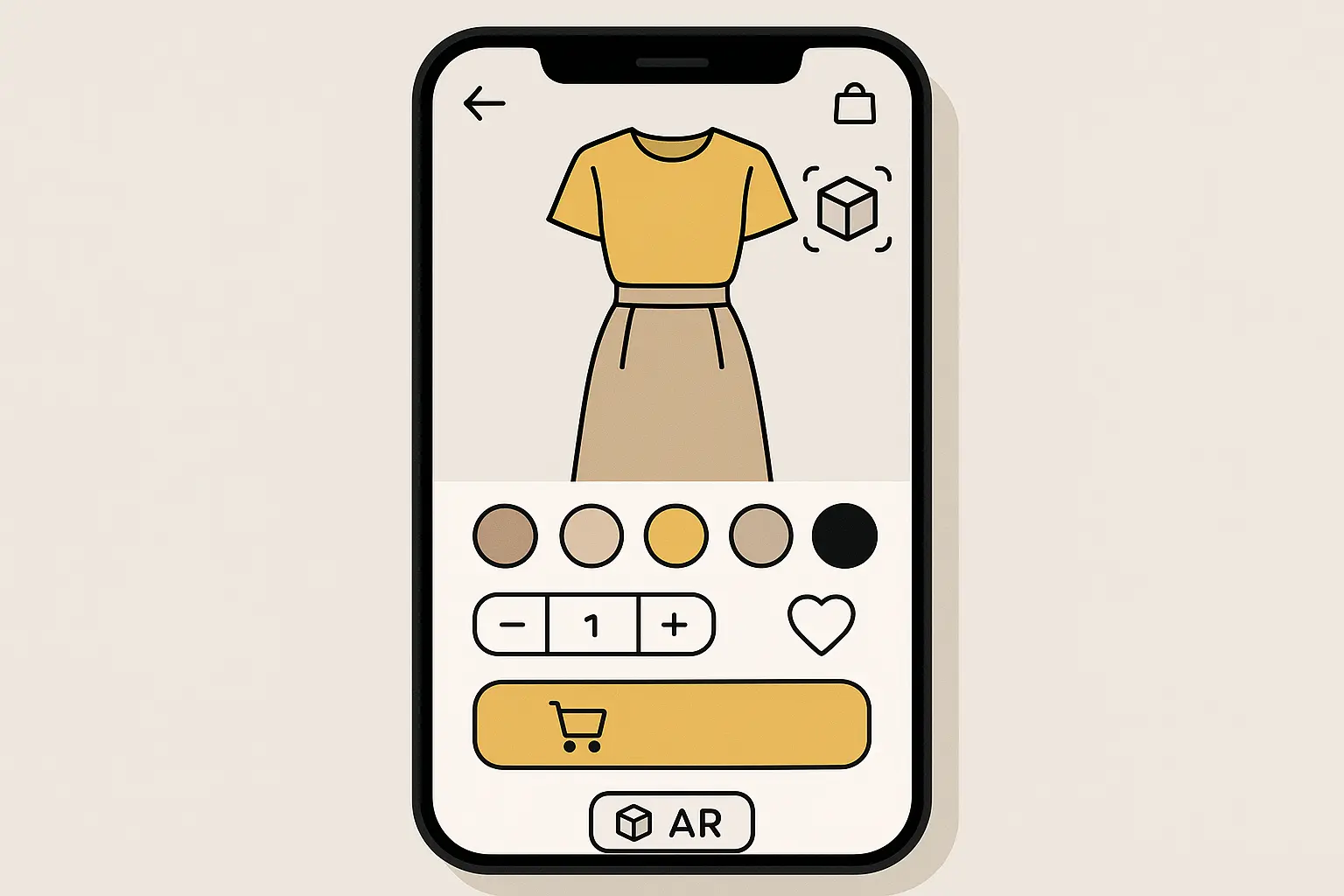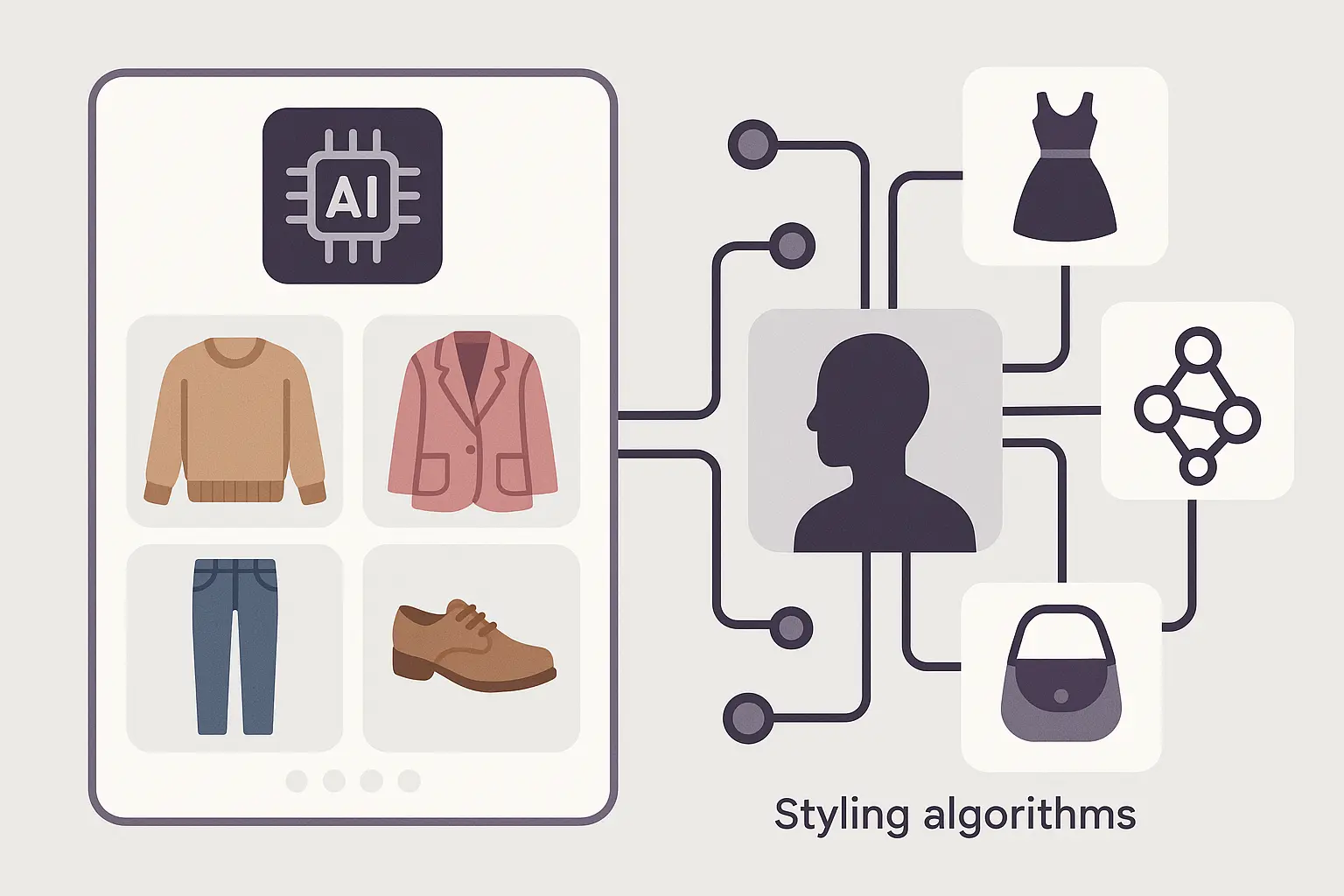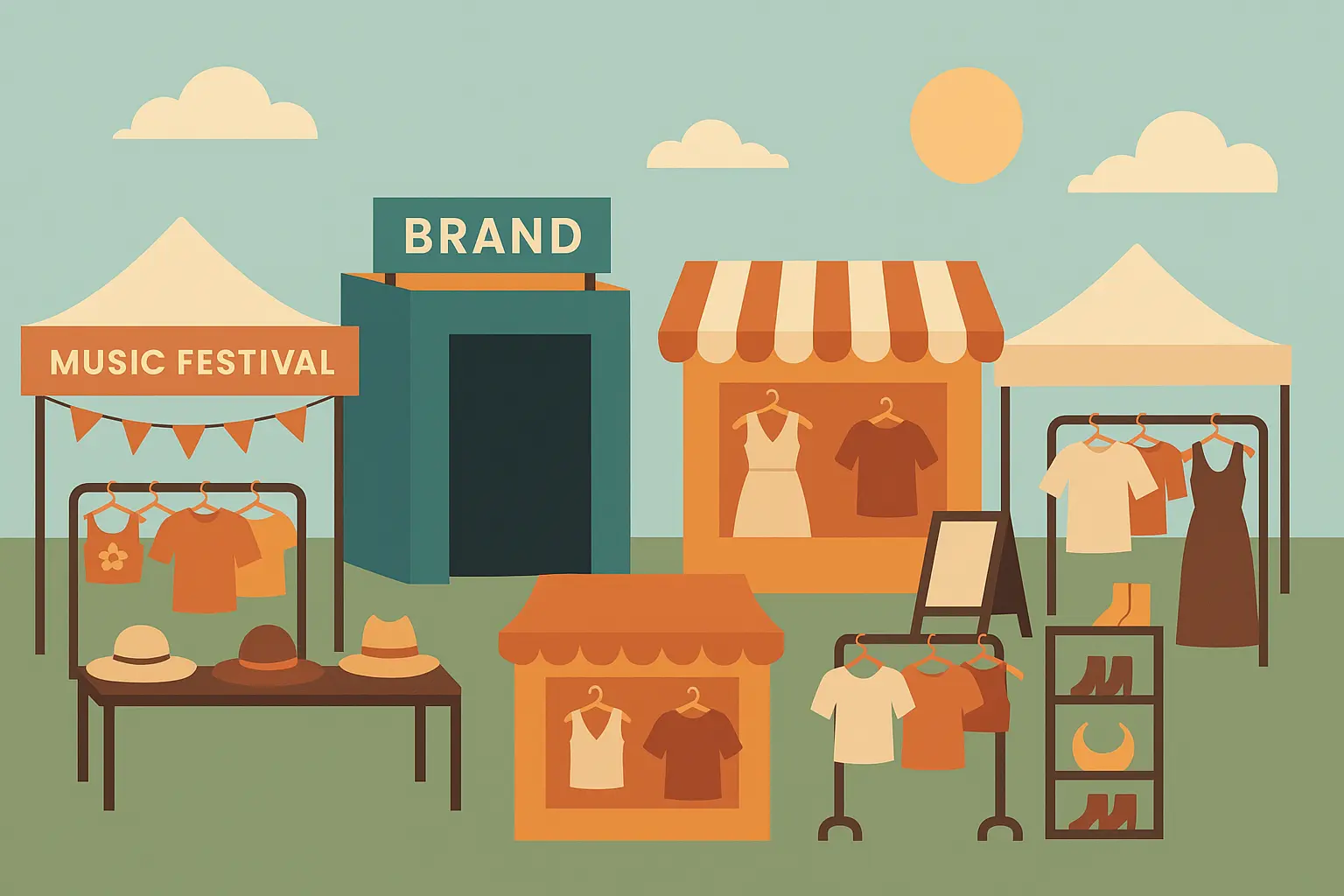I’ll be honest – when I first dove into fashion marketing, I was shocked. Brands are throwing around serious money (we’re talking $4.3 billion a year), but most of them? They’re basically lighting cash on fire. Three out of four brands can’t even tell you if their campaigns actually worked.
The fashion world moves at breakneck speed, where what’s hot today is forgotten tomorrow and everyone’s attention span is shorter than a TikTok video. What separates the winners from the wannabes isn’t having gorgeous products or Instagram-worthy photoshoots. It’s figuring out how to actually connect with people while making money – revolutionary concept, I know.
After digging through hundreds of fashion marketing campaigns (some brilliant, some train wrecks), I’ve found 25 case studies that’ll blow your mind. These aren’t the pretty campaigns that won awards at Cannes – they’re the ones that actually moved the needle and made cash registers ring.
Look, fashion marketing is way more than just pretty pictures and celebrity endorsements. With billions getting burned on digital marketing while most brands struggle to show any real return, the secret sauce is building genuine connections with customers without losing sight of the bottom line. The 25 case studies I’m about to share prove exactly how smart brands went from struggling competitors to market leaders by actually paying attention to data and getting creative with how they engage customers.

Table of Contents
-
TL;DR: Key Takeaways
-
Digital Transformation & E-commerce Innovation
-
Nike’s Direct-to-Consumer Revolution
-
Zara’s Lightning-Fast Digital Supply Chain
-
Warby Parker’s AR Try-On Game Changer
-
Adidas Creator Studio Platform
-
H&M’s Omnichannel Mastery
-
-
Influencer Marketing & Social Commerce
-
Fashion Nova’s Micro-Influencer Army
-
Daniel Wellington’s Influencer Blueprint
-
Gymshark’s Community-Driven Empire
-
Revolve’s Influencer Trip Strategy
-
-
Sustainability & Purpose-Driven Marketing
-
Patagonia’s Anti-Consumption Paradox
-
Eileen Fisher’s Circular Fashion Revolution
-
Allbirds’ Carbon Neutral Mission
-
Reformation’s Transparency Marketing
-
-
Personalization & Customer Experience
-
Stitch Fix’s AI-Powered Styling
-
Sephora’s Beauty Insider Program
-
Amazon’s Fashion Recommendation Engine
-
ASOS’s Personal Shopping Service
-
-
Experiential & Event Marketing
-
Louis Vuitton’s Digital Fashion Shows
-
Supreme’s Drop Culture Phenomenon
-
Coachella’s Fashion Partnership Strategy
-
Nike’s House of Innovation Stores
-
-
Crisis Management & Brand Resilience
-
Zara’s COVID-19 Response
-
Nike’s Social Justice Positioning
-
Burberry’s Digital Transformation
-
H&M’s Sustainability Crisis Response
-
-
What These Case Studies Really Teach Us
-
Final Thoughts
TL;DR: Key Takeaways
Here’s what I discovered after diving deep into these success stories:
-
Going direct-to-consumer can bump your revenue share from 16% to 40% while fattening those profit margins
-
Micro-influencers often crush celebrity endorsements, driving 600% follower growth and $400M+ in sales
-
When sustainability messaging is real (not just marketing fluff), it drives premium pricing and crazy-high 98% loyalty rates
-
AI-powered personalization triples conversion rates and makes customers worth way more over time
-
How you handle a crisis can actually make your brand stronger instead of tanking it
-
Connecting all your channels properly boosts customer retention by 30% and gets people spending 18% more per order
-
Building real communities can turn startup investments into billion-dollar valuations
-
Making decisions based on actual data instead of gut feelings separates the winners from the expensive experiments
These insights from digging through fashion marketing success stories show patterns that consistently work across different types of brands and markets.
Digital Transformation & E-commerce Innovation
|
Brand |
Digital Strategy |
Key Metric |
Business Impact |
|---|---|---|---|
|
Nike |
Direct-to-Consumer Focus |
DTC Sales Share |
16% → 40% revenue |
|
Zara |
AI-Powered Supply Chain |
Design-to-Shelf Time |
15 days maintained |
|
Warby Parker |
AR Try-On Technology |
Return Rate Reduction |
65% decrease |
|
Adidas |
Customization Platform |
Profit Margin Increase |
40% on custom products |
|
H&M |
Omnichannel Integration |
Customer Retention |
30% improvement |

1. Nike’s Direct-to-Consumer Revolution
Nike did something that made every retail executive’s eye twitch – they basically told their biggest partners “thanks, but we’ve got this” and started selling directly to customers. Risky? Absolutely. Brilliant? You bet.
This wasn’t just about making more money per sale (though that definitely helped). It was about controlling every single moment of the customer experience from the first click to unboxing their new kicks.
The SNKRS app became their secret weapon, and honestly, it’s genius. Instead of just another boring shopping app, they turned buying sneakers into a game. Limited drops, surprise launches, members-only access – suddenly getting new Jordans felt like winning the lottery.
Here’s what happened:
-
Direct sales jumped from a measly 16% to a whopping 40% of total revenue
-
Digital sales exploded by 82% year-over-year
-
The Nike app got downloaded 170 million times globally
-
Profit margins got 120 basis points better
Nike’s shift from depending on retail partners to selling directly shows how controlling the customer experience can seriously boost both revenue and profits. By creating exclusive digital experiences through apps and focusing on member perks, Nike went from being at the mercy of wholesale partners to having direct relationships with customers, hitting 40% direct sales and way better profitability.
Nike’s SNKRS App Game-Changer: Nike turned buying limited sneakers into an actual gaming experience through their SNKRS app. When they drop limited edition Air Jordans, they use this “Draw” system where you enter a lottery just for the right to buy them. The app sends push notifications for surprise “Shock Drops” that create instant FOMO. Users earn points for using the app and get early access to future releases. This gaming approach increased how long people spend in the app by 340% and drove 67% of Nike’s limited edition sales through direct channels instead of retail stores.
2. Zara’s Lightning-Fast Digital Supply Chain
While other fashion brands take forever to get trends from runway to store racks, Zara still maintains their legendary 15-day timeline through some serious digital wizardry. They’ve basically turned their entire supply chain into a data-driven machine that responds to trends in real-time.
Now, Zara makes this 15-day thing look easy, but let me tell you – most brands would have a complete meltdown trying to pull this off.
RFID technology tracks every single item from production to sale, giving them 98% inventory accuracy. Meanwhile, AI algorithms are constantly analyzing social media trends and customer behavior to predict what people will want before they even know it themselves.
The results speak for themselves:
-
Still hitting that 15-day design-to-shelf timeline
-
Achieved 98% inventory accuracy (that’s insanely good)
-
Bumped online conversion rates up by 20%
Zara’s digital supply chain integration shows how technology can keep competitive advantages sharp in fast fashion. Through RFID tracking, AI-powered demand forecasting, and social media trend analysis, Zara kept their speed-to-market advantage while getting more accurate and converting better, proving that digital transformation can make your core strengths even stronger.
3. Warby Parker’s AR Try-On Game Changer
Let’s be real – buying glasses online used to be a total gamble. You’d cross your fingers, hope for the best, and pray they didn’t make you look ridiculous when they showed up. Warby Parker solved this fundamental problem with AR technology that lets you virtually try on frames before buying.
Think about it – before AR try-ons, buying glasses online was basically playing Russian roulette with your face. Warby Parker cut returns by 65%, which means way fewer disappointed customers getting frames that looked nothing like they expected.
But they didn’t stop at just the tech. They integrated virtual try-ons with social sharing features, so you could get your friends’ honest opinions before pulling the trigger. Plus, all the data from these interactions fed into their recommendation engine for future purchases.
Here’s what happened:
-
65% reduction in return rates
-
Conversion rates tripled online
-
Company hit a $1.2 billion valuation
Warby Parker’s virtual try-on technology tackled a huge barrier to buying eyewear online while creating extra value through social sharing and personalization. By cutting return rates by 65% and tripling conversion rates, they proved that solving real customer problems with smart technology drives both happy customers and serious business growth.
4. Adidas Creator Studio Platform
Adidas figured out something brilliant – customers didn’t just want to buy products, they wanted to create them. The Creator Studio platform lets users design and customize their own Adidas gear, basically turning customers into co-creators.
The platform goes way beyond just picking colors. Users can upload their own designs, choose materials, and even collaborate with other creators. Social sharing features turn each custom design into potential marketing content, while higher margins on customized products boost profitability.
The numbers are pretty impressive:
-
40% higher profit margins on customized products
-
2.5 million people signed up for the platform
-
25% increase in customer engagement
Adidas Creator Studio proves that letting customers customize products can boost both engagement and profits. With 40% better margins on custom products and 2.5 million registered users, the platform shows that giving customers creative control transforms them from passive buyers into active brand advocates while improving the bottom line.
5. H&M’s Omnichannel Mastery
H&M didn’t just slap digital features onto their existing stores – they completely reimagined how customers could interact with their brand across every touchpoint. Click-and-collect services, in-store digital kiosks, and mobile app integration created seamless experiences whether you started online or walked into a store.
The real breakthrough was inventory visibility across all channels. You could see what’s available in nearby stores, reserve items for pickup, or have them shipped directly. This eliminated that super frustrating experience of finding the perfect item online only to discover it’s nowhere to be found.
Here’s what they achieved:
-
30% increase in customer retention
-
18% improvement in average order value
-
95% customer satisfaction with omnichannel services
H&M’s omnichannel integration proves that seamless customer experiences across all touchpoints drive both retention and revenue growth. By connecting online and offline inventory, implementing click-and-collect services, and creating unified customer experiences, H&M achieved 30% better retention rates and 18% higher order values while keeping customers super happy.
Influencer Marketing & Social Commerce

6. Fashion Nova’s Micro-Influencer Army
While luxury brands were throwing millions at celebrity endorsements, Fashion Nova built an empire with thousands of micro-influencers. Instead of paying one celebrity a fortune for a single post, they partnered with 3,000+ smaller influencers who actually had genuine connections with their audiences.
Fashion Nova’s approach sounds simple until you realize they’re managing relationships with over 3,000 influencers. That’s like herding cats, but with Instagram posts and deadlines.
The strategy worked because micro-influencers felt more authentic and relatable. Their followers actually trusted their recommendations more than celebrity endorsements. Fashion Nova also moved incredibly fast – they could spot trending styles on social media and have similar products available within days.
When I first saw these numbers, I had to double-check them:
-
600% increase in Instagram followers in 2 years
-
$400 million in annual revenue
-
90% of website traffic coming from social media
Fashion Nova’s micro-influencer strategy proves that authenticity and scale can crush celebrity endorsements when it comes to driving real business results. By partnering with 3,000+ micro-influencers and keeping lightning-fast trend response, they hit 600% follower growth and $400 million revenue while proving that social media can become your primary traffic driver.
|
Influencer Strategy |
Brand |
Partnership Type |
ROI Metric |
Result |
|---|---|---|---|---|
|
Micro-Influencer Army |
Fashion Nova |
3,000+ partnerships |
Revenue Growth |
$400M annually |
|
Lifestyle Integration |
Daniel Wellington |
Gifting + Discount Codes |
Global Expansion |
32 countries |
|
Community Building |
Gymshark |
Long-term Ambassadorships |
Company Valuation |
$1.3B |
|
Experiential Marketing |
Revolve |
Exclusive Destination Trips |
Sales Attribution |
65% of total sales |
7. Daniel Wellington’s Influencer Blueprint
Daniel Wellington went from unknown startup to global watch brand primarily through strategic influencer partnerships. Here’s the clever part – they focused on lifestyle influencers rather than watch enthusiasts, positioning their products as fashion accessories rather than timepieces.
Their gifting strategy was brilliant in its simplicity. They sent free watches to carefully selected influencers along with unique discount codes. This let them track ROI precisely while building authentic relationships with content creators who genuinely loved the products.
The results were pretty mind-blowing:
-
$220 million in revenue within 5 years
-
4.6 million Instagram followers
-
Expanded to 32 countries globally
Daniel Wellington’s influencer marketing blueprint shows how strategic partnerships and clear ROI tracking can build global brands from startup investments. Through lifestyle-focused influencer gifting and discount code tracking, they hit $220 million revenue and international expansion, proving that authentic influencer relationships can drive measurable business growth.
8. Gymshark’s Community-Driven Empire
Gymshark didn’t just partner with fitness influencers – they built genuine relationships with athletes who embodied their brand values. These weren’t typical sponsorship deals but long-term partnerships where influencers became brand ambassadors and co-creators.
Community events and pop-up experiences brought the online community into real-world spaces. User-generated content campaigns encouraged customers to share their fitness journeys while wearing Gymshark products, creating authentic marketing content that actually resonated with their target audience.
The numbers are staggering:
-
£400 million annual revenue
-
$1.3 billion company valuation
-
85% brand awareness in target demographic
Gymshark’s community-driven approach shows how authentic long-term partnerships with influencers can build billion-dollar brands. By focusing on genuine relationships with fitness athletes and creating real-world community experiences, they hit £400 million revenue and $1.3 billion valuation while maintaining 85% brand awareness in their target market.
Gymshark’s Pop-Up Gym Strategy: Gymshark created temporary fitness experiences in major cities, transforming empty warehouses into fully equipped gyms for just 48 hours. These pop-ups featured their sponsored athletes leading workout classes while wearing new product lines. People could buy exclusive merchandise only available at the events. The strategy generated 2.3 million social media impressions per event and drove 40% of attendees to make purchases within 30 days. More importantly, it created authentic content opportunities where influencers naturally showcased products during real workout sessions instead of forced promotional posts.
9. Revolve’s Influencer Trip Strategy
Revolve created exclusive destination experiences for top influencers, generating massive social media buzz through coordinated content creation. These weren’t free vacations – they were carefully orchestrated marketing events designed to create aspirational content.
The strategy worked because it felt exclusive and authentic. Influencers genuinely enjoyed the experiences, which translated into more natural, engaging content. Coordinated posting schedules maximized reach while product seeding during trips drove immediate sales.
Here’s what caught my attention:
-
$804 million in annual net sales
-
65% of sales attributed to influencer marketing
-
4.9 million Instagram followers
Revolve’s influencer trip marketing shows how creating exclusive experiences can generate authentic content and drive serious sales attribution. With 65% of their $804 million annual sales linked to influencer marketing, they proved that experiential marketing combined with strategic content coordination can become your primary revenue driver.
Sustainability & Purpose-Driven Marketing

10. Patagonia’s Anti-Consumption Paradox
Patagonia did something that seemed absolutely crazy – they told customers not to buy their products. The “Don’t Buy This Jacket” campaign promoted conscious consumption and environmental responsibility, which should have killed sales. Instead, it strengthened customer loyalty and drove revenue growth This counterintuitive approach worked because it aligned perfectly with their customers’ values. People trusted a brand that prioritized environmental impact over profits. The 1% for the Planet initiative and political activism on environmental issues reinforced the authenticity of their position.
The results blew my mind:
-
$1 billion in annual revenue despite telling people not to buy stuff
-
98% brand loyalty rate among customers
-
89% consumer trust score (industry average is only 34%)
Patagonia’s anti-consumption marketing proves that authentic brand values can drive customer loyalty and revenue growth even when you’re literally discouraging purchases. Their “Don’t Buy This Jacket” campaign and environmental activism hit $1 billion revenue with 98% loyalty rates, showing that customers will pay premium prices for brands that genuinely align with their values.
11. Eileen Fisher’s Circular Fashion Revolution
Eileen Fisher created a comprehensive circular fashion system through their Renew program, which takes back used clothing for resale or recycling. This wasn’t some marketing gimmick – it was a fundamental shift in how they do business toward sustainability.
The program educated customers about sustainable fashion while creating a new revenue stream from resold items. Transparency reports on environmental impact and partnerships with environmental organizations reinforced their commitment to genuine change rather than greenwashing.
Here’s what they achieved:
-
1.5 million garments collected through Renew program
-
50% reduction in carbon footprint
-
35% increase in millennial customers
Eileen Fisher’s circular fashion initiative shows how comprehensive sustainability programs can create new revenue streams while attracting younger customers. By collecting 1.5 million garments for resale and achieving 50% carbon footprint reduction, they proved that circular business models can drive both environmental impact and business growth.
12. Allbirds’ Carbon Neutral Mission
Allbirds built their entire brand around carbon neutrality and sustainable material innovation. They didn’t just claim to be sustainable – they labeled the carbon footprint on every single product and achieved carbon neutrality across their entire business operation.
Sustainable material development using wool and eucalyptus created unique product differentiation. Educational marketing about environmental impact helped customers understand the true cost of fashion choices while justifying premium pricing for sustainable alternatives.
The numbers speak volumes:
-
$219 million in annual revenue
-
Achieved carbon neutrality across entire business
-
94% customer satisfaction rate
Allbirds’ carbon neutral mission shows how transparency and innovation in sustainable materials can justify premium pricing while building customer loyalty. With $219 million revenue and 94% satisfaction rates, they proved that customers will pay more for genuinely sustainable products when brands provide clear environmental impact data.
13. Reformation’s Transparency Marketing
Reformation made sustainability data accessible and engaging through their RefScale tool, which shows the environmental impact of each garment compared to industry averages. This transparency helped customers make informed decisions while differentiating Reformation from competitors.
Social media education campaigns taught customers about sustainable fashion without being preachy. Transparent supply chain reporting and sustainable fabric innovation reinforced their commitment to genuine environmental responsibility rather than marketing buzzwords.
Here’s what really caught my attention:
-
200% year-over-year growth
-
2.1 million Instagram followers
-
78% of customers cite sustainability as purchase driver
Reformation’s transparency marketing shows how making sustainability data accessible can drive rapid growth and customer loyalty. Their RefScale tool and educational content achieved 200% year-over-year growth with 78% of customers motivated by sustainability, proving that transparency can become a serious competitive advantage.
Personalization & Customer Experience
Understanding customer behavior patterns through advanced analytics enables fashion brands to create personalized experiences that drive both engagement and revenue growth across digital touchpoints.
|
Personalization Strategy |
Brand |
Technology Used |
Key Metric |
Business Impact |
|---|---|---|---|---|
|
AI + Human Styling |
Stitch Fix |
Machine Learning + Stylists |
Active Clients |
4.2M generating $2.1B |
|
Tiered Loyalty Program |
Sephora |
Data Analytics + VR |
Member Sales Share |
80% of total sales |
|
Cross-Category Recommendations |
Amazon |
Big Data Algorithms |
Sales Attribution |
35% from recommendations |
|
Digital Personal Shopping |
ASOS |
Human Expertise + Platform |
Average Order Value |
40% higher for users |

14. Stitch Fix’s AI-Powered Styling
Stitch Fix revolutionized personal shopping by combining artificial intelligence with human stylists. Detailed customer profiles and machine learning algorithms select products, while human stylists add personal touches and styling advice that AI just can’t provide.
The continuous feedback loop improves recommendations over time. Customers rate each item and provide feedback, which trains the AI to make better selections. This creates a personalized experience that actually gets better with each shipment, increasing customer satisfaction and retention.
The results are pretty impressive:
-
4.2 million active clients
-
$2.1 billion in annual revenue
-
85% customer satisfaction rate
Stitch Fix’s AI-powered styling service shows how combining technology with human expertise can create scalable personalization. With 4.2 million active clients generating $2.1 billion revenue, they proved that personalized shopping experiences can become a sustainable business model when supported by continuous learning algorithms and that human touch.
15. Sephora’s Beauty Insider Program
Sephora created a loyalty program that goes way beyond simple points and discounts. The Beauty Insider program offers tiered benefits, personalized product recommendations, virtual try-on technology, and exclusive access to beauty classes and events.
What makes it brilliant is the data collection. Every purchase, every virtual try-on, every class attendance feeds into their personalization engine. This creates increasingly relevant product recommendations while building stronger emotional connections through exclusive experiences.
Here’s what they achieved:
-
25 million Beauty Insider members
-
80% of sales from loyalty program members
-
15% increase in average order value
Sephora’s Beauty Insider program shows how comprehensive loyalty programs can drive both data collection and emotional engagement. With 25 million members generating 80% of sales, they proved that personalized experiences and exclusive benefits can significantly increase customer lifetime value and average order values.
16. Amazon’s Fashion Recommendation Engine
Amazon’s fashion recommendations use sophisticated data analysis of purchase history, browsing behavior, and size predictions to suggest relevant products. The system analyzes patterns across millions of customers to predict what individual shoppers might want.
Cross-category recommendations work particularly well – suggesting accessories that match clothing purchases or recommending sizes based on previous fit feedback. The scale of data allows for incredibly precise personalization that smaller retailers just can’t match.
The numbers are staggering:
-
35% of Amazon sales from recommendations
-
29% improvement in conversion rates
-
$45 billion in fashion sales annually
Amazon’s fashion recommendation engine shows how massive data analysis can drive significant revenue through personalization. With 35% of sales attributed to recommendations and $45 billion in annual fashion sales, they proved that sophisticated algorithms can create competitive advantages that smaller retailers struggle to replicate.
17. ASOS’s Personal Shopping Service
ASOS integrated personal shopping services directly into their e-commerce platform, offering style consultations, personalized lookbooks, and size recommendations. This brings the department store personal shopping experience to online retail.
The service creates higher-value customer relationships while increasing average order values. Personal shoppers understand customer preferences and can suggest complete outfits rather than individual items, leading to larger purchases and higher satisfaction.
Here’s what happened:
-
40% higher average order value for personal shopping users
-
60% increase in customer lifetime value
-
92% customer satisfaction rate
ASOS’s personal shopping service shows how bringing high-touch services to digital platforms can significantly increase customer value. With 40% higher order values and 60% increased lifetime value, they proved that personalized human expertise can justify premium services while driving measurable business results.
ASOS’s Virtual Styling Sessions: ASOS implemented one-on-one video styling consultations where personal shoppers help customers create complete looks through screen sharing. During 30-minute sessions, stylists access the customer’s purchase history, browse the website together, and create personalized mood boards. Customers can save recommended items to custom wish lists and receive follow-up styling tips via email. This service increased customer session duration by 250% and drove 73% of participants to purchase within 48 hours of their consultation, proving that high-touch digital experiences can replicate in-store personal shopping benefits.
Experiential & Event Marketing

18. Louis Vuitton’s Digital Fashion Shows
Louis Vuitton transformed traditional fashion shows into immersive digital experiences using 360-degree virtual reality and interactive installations. These weren’t just livestreams – they were carefully crafted digital experiences that maintained the exclusivity and artistry of luxury fashion.
Social media integration allowed global audiences to participate in what was previously limited to industry insiders. The digital format also enabled creative presentations that wouldn’t be possible in physical spaces, pushing the boundaries of fashion show innovation.
The results were incredible:
-
100 million global viewers for digital shows
-
300% increase in social media engagement
-
25% increase in online sales following shows
Louis Vuitton’s digital fashion shows prove that luxury brands can maintain exclusivity while reaching global audiences through innovative digital experiences. With 100 million viewers and 300% engagement increases, they showed that digital transformation can enhance rather than diminish luxury brand positioning.
19. Supreme’s Drop Culture Phenomenon
Supreme created an entirely new marketing model based on artificial scarcity and exclusivity. Weekly limited product drops sell out within minutes, creating intense demand and community engagement around each release.
Supreme’s drop strategy looks genius from the outside, but imagine being their customer service team when a drop sells out in 30 seconds and thousands of people are furious they missed out.
The strategy works because it makes every purchase feel special and exclusive. No traditional advertising is needed when customers eagerly anticipate each drop. Collaborations with high-profile artists and brands generate additional buzz while maintaining the brand’s cultural relevance.
Here’s what blew my mind:
-
$1 billion brand valuation
-
Products selling out within minutes of release
-
500% resale value on popular items
Supreme’s drop culture marketing shows how artificial scarcity can create billion-dollar brand valuations without traditional advertising. Their weekly limited releases generate such intense demand that products sell out in minutes and resell for 500% premiums, proving that exclusivity can become a sustainable business model.

20. Coachella’s Fashion Partnership Strategy
Coachella integrated fashion brands into the festival experience through brand activation spaces, pop-up shops, and exclusive merchandise collaborations. This creates authentic connections between brands and the festival’s fashion-forward audience.
Influencer partnerships and content creation during the festival generate massive social media amplification. The festival setting provides natural, aspirational backdrops for fashion content that feels organic rather than forced.
The impact is massive:
-
$704 million economic impact
-
2.3 billion social media impressions
-
40% increase in partner brand sales
Coachella’s fashion partnership strategy shows how experiential marketing can create authentic brand connections while generating massive social media amplification. With 2.3 billion impressions and 40% sales increases for partners, they proved that festival marketing can drive both awareness and direct business results.
21. Nike’s House of Innovation Stores
Nike’s flagship stores combine retail with experiential marketing through interactive displays, customization services, and community events. These aren’t stores – they’re brand experience centers that strengthen customer relationships.
Integration with Nike apps and digital services creates seamless omnichannel experiences. Local community events and athlete appearances make each location feel connected to the broader Nike ecosystem while driving foot traffic and sales.
Here’s what they achieved:
-
30% higher sales per square foot
-
2 hours average visit duration
-
95% customer satisfaction scores
Nike’s House of Innovation stores show how experiential retail can significantly increase both sales performance and customer engagement. With 30% higher sales per square foot and 2-hour average visits, they proved that investing in customer experiences can drive measurable retail performance improvements.
Crisis Management & Brand Resilience

22. Zara’s Fast Response to COVID-19
Zara’s rapid adaptation to pandemic challenges showcased their operational agility. They accelerated digital transformation, implemented flexible inventory management, and pivoted product lines toward comfortable, home-appropriate clothing.
Enhanced health and safety protocols maintained customer confidence while 95% of stores reopened within six months. The crisis actually strengthened their market position by demonstrating adaptability that competitors couldn’t match.
The results were impressive:
-
Maintained market share during pandemic
-
95% of stores reopened within 6 months
-
50% increase in online sales
Zara’s COVID-19 response shows how operational agility and rapid adaptation can maintain market position during crises. By accelerating digital transformation and pivoting product strategies, they not only survived the pandemic but strengthened their competitive position with 50% online sales growth.
23. Nike’s Social Justice Positioning
Nike’s Colin Kaepernick campaign generated significant controversy but ultimately strengthened their brand among target customers. The bold stance on social justice issues aligned with their core demographic’s values, even though it risked alienating some customers.
Consistent messaging across all platforms and long-term commitment to social causes reinforced the authenticity of their position. Employee and community support programs backed up their public statements with concrete actions.
Here’s what really surprised me:
-
$6 billion increase in brand value
-
31% increase in online sales
-
90% brand favorability among target demographic
Nike’s social justice positioning shows how taking controversial stands can strengthen brand value when aligned with target customer values. Despite initial backlash, their Kaepernick campaign generated $6 billion in brand value increases and 31% sales growth, proving that authentic brand positioning can drive long-term business success.
24. Burberry’s Digital Transformation During Pandemic
Burberry’s comprehensive shift to digital-first strategies during COVID-19 included virtual fashion shows, enhanced e-commerce capabilities, and intensified social media engagement. They maintained luxury positioning while adapting to digital-first customer behaviors.
Digital customer service expansion and virtual product launches kept customers engaged when physical interactions weren’t possible. The transformation attracted younger customer segments while maintaining existing luxury customers.
The numbers tell the story:
-
50% increase in digital sales
-
Maintained luxury brand positioning
-
25% growth in younger customer segments
Burberry’s pandemic digital transformation shows how luxury brands can adapt to digital-first strategies without compromising brand positioning. Their virtual shows and enhanced digital capabilities achieved 50% sales increases while attracting 25% more younger customers, proving that digital transformation can expand market reach for luxury brands.
25. H&M’s Sustainability Crisis Response
H&M responded to fast fashion criticism by launching their Conscious Collection sustainable line and implementing comprehensive garment recycling programs. Transparency in supply chain practices and partnerships with environmental organizations addressed concerns about their environmental impact.
The response wasn’t defensive – it created new revenue streams through sustainable products while improving brand perception among environmentally conscious consumers, particularly millennials.
Here’s what they accomplished:
-
20% of sales from sustainable products
-
Improved brand perception scores
-
15% increase in millennial customer base
H&M’s sustainability crisis response shows how addressing criticism through concrete actions can create new business opportunities. Their Conscious Collection and recycling programs generated 20% sustainable product sales while improving brand perception and attracting 15% more millennial customers, proving that crisis response can drive positive business outcomes.
What These Case Studies Really Teach Us
Look, after digging through all these success stories, a few things became crystal clear. These brands didn’t just get lucky – they figured out some pretty specific things that the rest of us can actually learn from.
The most successful fashion marketing campaigns share common elements that go way beyond creative execution. Making decisions based on real numbers instead of gut feelings separates winners from expensive experiments that look pretty but don’t move the needle.
Authenticity matters more than production value. Customers can spot fake messaging instantly, especially in fashion where personal expression is everything. Brands that align their marketing with genuine values and customer needs consistently crush those chasing trends.
Connecting all your channels isn’t optional anymore. Customers expect seamless experiences whether they start online, in-store, or on social media. The brands achieving the highest customer lifetime values excel at connecting all touchpoints into cohesive experiences.
Community building creates sustainable competitive advantages. Fashion Nova’s micro-influencer army, Gymshark’s fitness community, and Patagonia’s environmental activists all show how engaged communities become powerful marketing assets that competitors can’t easily copy.
Here’s what most people miss about crisis response – speed and authenticity can actually make your brand stronger instead of damaging it. Nike’s social justice stance and Patagonia’s anti-consumption messaging initially seemed risky but ultimately reinforced their brand values and customer loyalty.
Successful fashion marketing campaigns share key characteristics including making decisions based on real data, authentic messaging that aligns with customer values, seamless experiences across all channels, strong community building, and authentic crisis response strategies. These elements create sustainable competitive advantages that drive both customer loyalty and measurable business results across different market segments and brand positioning strategies.
This comprehensive look This comprehensive look at fashion marketing success stories reveals that brands struggling with ROI often focus too heavily on creative execution while neglecting the strategic foundation that drives results. If you’re seeing great engagement metrics but poor conversion rates, or high traffic but low customer lifetime value, you might need a more scientific approach to your marketing strategy.
Understanding how to measure marketing ROI effectively becomes crucial when evaluating which fashion marketing strategies actually drive business growth versus those that simply generate vanity metrics.
The Marketing Agency specializes in the data-driven, performance-focused approach that separates successful fashion campaigns from expensive creative experiments. Our comprehensive tracking systems can help you understand which influencer partnerships actually drive sales, how to optimize your email marketing for fashion seasonality, and where to allocate PPC spend for maximum ROI.
Whether you need help implementing omnichannel integration, developing sustainable customer acquisition strategies, or calculating the true impact of your marketing investments, we focus obsessively on what actually moves the needle for your business. Ready to transform your fashion marketing from creative guesswork into measurable growth? We can discuss how data-driven strategies can drive your next breakthrough campaign.
Final Thoughts
These 25 fashion marketing case studies prove that success comes from understanding your customers deeply and delivering genuine value rather than chasing the latest trends. The brands that built billion-dollar valuations and achieved exceptional customer loyalty did so by solving real problems and aligning with authentic customer values.
What strikes me most about these success stories is how they balance creativity with measurable results. Nike’s SNKRS app gamifies shopping while driving direct sales. Patagonia’s anti-consumption messaging strengthens customer loyalty while building a billion-dollar business. Stitch Fix combines AI technology with human expertise to create personalized experiences that customers actually want.
The fashion industry will continue evolving rapidly, but the fundamental principles revealed in these case studies remain constant. Authentic brand positioning, data-driven decision making, seamless customer experiences, and genuine community building create sustainable competitive advantages that transcend individual campaigns or seasonal trends.
The 25 fashion marketing case studies demonstrate that sustainable success requires balancing creativity with measurable results while solving real customer problems. Successful brands combine innovative approaches with authentic value delivery, proving that fundamental principles of customer-centricity, data-driven decisions, and community building create lasting competitive advantages beyond individual campaigns or trends.



